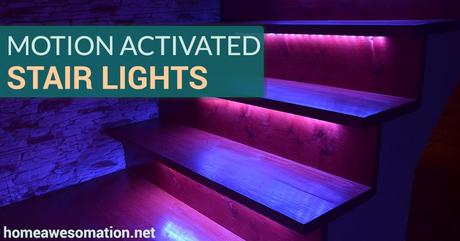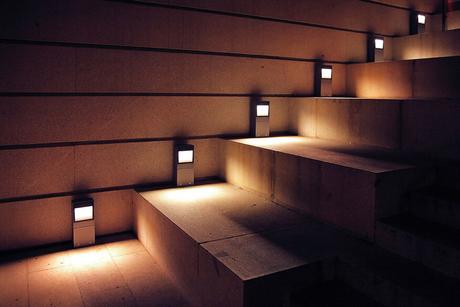Knowledge is power...share it!
If you've ever had to go up or down the stairs in the dark, you were probably closer to a major accident than you may think. According to the National Safety Council, staircase & stairway accidents are the 2 nd leading cause of accidental death in the US, leading to about 12,000 deaths per year.
In addition to defective stairs & unsafe design, poor lighting is one of the leading causes of stair falls - and also the most easily preventable. With motion lights for stairs, you can easily & effectively light your stairs to reduce the risk of you or a loved one getting hurt.

Motion activated stair lights are a great home automation idea and can be implemented quite easily in almost any home.
Why Use Motion Activated Stair Lights
With lighting playing such a major role in the safety of your stairs, adequate lighting is a no-brainer. However, standard ceiling lights at the top or the bottom of the stairs aren't always enough light and can also be incredibly inconvenient for the rest of the household.
Instead, you can choose a lighting option that only works when and where you need it.
Motion activated stair lights utilize a sensor that detects movement by or on the staircase, turning on the lights to make it easier to see where you're going.
By choosing motion lights for stairs over conventional lighting, you can:
Make It Safer to Traverse Stairs - The main perk of motion activated stair lights is that they make it easy to provide light on the stairs itself. While ambient lighting from windows & lights may be enough during the day, the absence of that light at night makes it much more uncertain.
With nearly all motion lights for stairs, the light is directed either across the steps themselves or comes up from the steps themselves with LED strips. You won't have to worry about shadows or sections that don't get ample lighting from other sources being a problem.
Keep the Light Pollution Down - If you're living with your family or roommates, you can't just turn on a big hall light to make your way down the stairs without disrupting others. With motion activated stair lighting, the lights will stay off until you need them. Once they're needed, the light will be isolated to just the staircase, preventing it from affecting others.
Save Energy - Another perk of motion activation is that you can control the time that the lights will stay on once triggered. Rather than a constant staircase of lights, you can only have them lit up for the time it takes to navigate the stairs - turning off afterwards and saving energy.
Choosing Your Type of Motion Light

Whether you're building your dream home or simply renting, you can ramp up the style and safety of your stairs with motion activated stair lights. They come in two primary configurations, with different costs, levels of convenience, and product options to choose from.
Individual (Stand Alone) Lights
When it comes to upgrading your stair lighting to motion activation, the most popular method is using individual lights that you can buy and install yourself. These are smaller, more affordable lights that often are mounted on the wall via a sticky pad or small mounting kit. They are primarily powered by battery, eliminating the need for wiring or advanced installation and making them portable.
With individual lights, each light will activate based on its own motion sensing technology, meaning that the lights will likely light up as you walk up or down the stairs rather than illuminating the whole thing at once.
They can also isolate the light to fewer stairs than more comprehensive lighting options, requiring more lights to provide ample visibility.
Hardwired Systems
A hardwired stairway lighting system is the more advanced, more expensive option for your motion activated stair lights, but also the most effective. These systems often include a motion sensor on the top and bottom of the staircase that triggers a smart outlet to turn on the lights it is connected to.
This system of lights is going to be interconnected, illuminating the entirety of the staircase at once to make it easier to traverse. The lights themselves can vary in type and style, with possibilities like flush-mounted LEDs in the wall that won't poke into the stairway as well as strip lighting that can go on the base of the stairs or on the stair risers to light up each individual step.
The downside of hardwired systems is that they often require advanced installation as well as other tools (motion sensors, wiring, smart outlets, etc.) to work effectively. This makes them more expensive and semi-permanent, so they're best for those who are starting a new project rather than adding on to an existing staircase.
Motion Lights For Stairs - For Safety Sake
When it comes to the safety of your home - especially for children and elderly people - staircases cannot go overlooked. With poor lighting being a major cause of stair-related accidents, it's incredibly important that you ensure that your stairs can be safely navigated at any time of day.
Fortunately, motion lights for stairs offer an affordable, convenient, and effective way to make your stairs safer regardless of the time of day.
